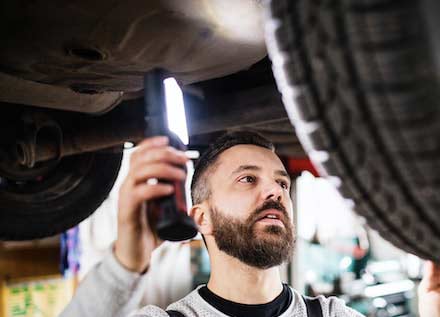Where safety stands and jack stands are used
Did you know that a safety stand is also is called a jack stand? These are indispensable tools in the realm of automotive maintenance and repair. These types of tools play a pivotal role in providing a secure and steady support structure for vehicles during various maintenance procedures.
Tire changes and stability
One of the most common applications of safety stands is during tire changes. When you need to replace your vehicle’s tires, safety stands ensure stability and security during the process. They act as a steadfast foundation, preventing the vehicle from toppling over while the tires are being switched.
Oil changes and Accessibility
Another crucial utilization of safety stands occurs during oil changes. These stands offer substantial support, allowing for convenient access to the oil drain plug and filter. By lifting the vehicle with a floor jack and securing it with safety stands, you can easily reach the components necessary for an oil change.
Brake repairs and elevation
Brake pad or rotor replacement requires the vehicle to be elevated safely and consistently. Safety stands fulfill this role admirably. They ensure that the vehicle remains steadily elevated, allowing for precise brake repairs without the risk of sudden movement or instability.
Exhaust system maintenance
When it comes to maintaining or repairing the exhaust system, safety stands are indispensable. They create the necessary clearance, ensuring that the technician has ample space to work underneath the vehicle. Safety and accessibility are paramount when dealing with exhaust system components.
How safety stands are used
Using safety stands effectively requires a systematic approach to guarantee safety and stability throughout the process.
Step 1: Lifting the vehicle
Begin by using a floor jack or hydraulic jack to raise the vehicle to the desired height. Always adhere to the recommended lifting points specified by the manufacturer. This ensures that the vehicle is raised evenly and securely.
Step 2: Positioning the safety stand
Place the safety stand under the vehicle’s frame or designated lifting points. Ensure that the surface beneath the stand is stable and level. Proper positioning is crucial to the stand’s effectiveness.
Step 3: Adjusting the height
Most safety stands come with adjustable support arms. Extend these arms to the appropriate height so that they securely contact the vehicle’s underside. This step guarantees that the vehicle is supported uniformly.
Step 4: Lowering the vehicle
Once the safety stands are in place and the vehicle is securely supported, carefully lower the vehicle onto the stands. Ensure that it rests evenly and firmly on the stands before initiating any maintenance or repair work.
These safety precautions and procedures are fundamental to the proper use of safety stands, ensuring both the safety of the technician and the stability of the vehicle during maintenance tasks. Read more about automotive workshop tools.
Importance of jack stands in vehicle maintenance
Vehicle safety
The paramount importance of safety stands in vehicle maintenance cannot be overstated. These devices are an integral aspect of ensuring the safety of individuals working in the proximity of lifted vehicles. Relying solely on a hydraulic jack, which can potentially fail or lose pressure over time, is a risky proposition. Safety stands act as a crucial safeguard, mitigating the risk of accidents.
Preventing accidents
One of the primary roles of safety stands is to act as a fail-safe mechanism. In the unfortunate event of a hydraulic jack failure or a sudden loss of pressure, the safety stands serve as the last line of defense. They bear the weight of the vehicle, preventing accidents that could otherwise result in severe injuries or even fatalities. Therefore, safety stands are indispensable tools for maintaining a secure and accident-free work environment in automotive maintenance and repair settings.
The types of safety stands for different vehicles
Weight capacity and size
Safety stands are available in various weight capacities and sizes to cater to the diverse range of vehicles encountered in automotive maintenance. Smaller stands with lower weight capacities are suitable for compact cars, while larger and heavier-duty stands are designed to handle the considerable weight of trucks and SUVs. It is imperative always to select safety stands with an appropriate weight capacity that matches the specific vehicle being worked on. This ensures both safety and effectiveness during maintenance tasks.
Adjustable vs. fixed height
Safety stands come in two primary configurations: adjustable and fixed height. Adjustable stands offer flexibility in terms of positioning the vehicle at different heights. These stands are particularly advantageous when dealing with vehicles that require various working heights. Fixed-height stands, on the other hand, are simpler in design but may necessitate precise positioning of the vehicle to achieve the desired working height. The choice between adjustable and fixed height stands depends on the specific requirements of the maintenance task at hand.

Complementary tools – Jacks and lifts
Hydraulic floor jacks
Hydraulic floor jacks complement safety stands in automotive maintenance tasks. They play a pivotal role in the initial lifting of the vehicle, raising it to the desired height. Hydraulic floor jacks are essential for positioning the vehicle correctly before the stands are employed. These jacks are designed to provide controlled and consistent lifting, which is crucial for the safe and effective usage.
Vehicle lifts and ramps
In professional automotive garages, vehicle lifts and ramps are commonly employed for more extensive repair and inspection procedures. These lifts and ramps offer greater clearance and accessibility compared to standard floor jacks. However, even when vehicle lifts or ramps are utilized, safety stands continue to play a critical role as secondary support mechanisms. Placing stands beneath the lifted vehicle adds an extra layer of security, ensuring that the vehicle remains stable and protected throughout the duration of the maintenance task.
With these jack stands, automotive technicians can maintain a safer and more efficient working environment. Safety stands are not just accessories; they are an essential component of vehicle maintenance safety protocols.
Read more about workplace safety in the article: The importance of emergency shower signs for workplace safety.



